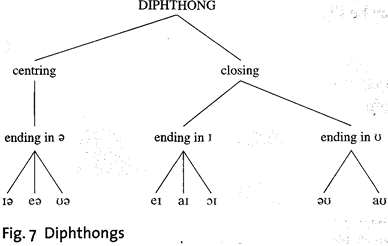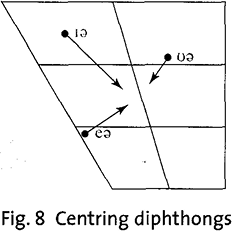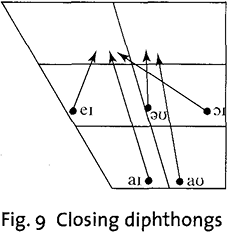


 Grammar
Grammar
 Tenses
Tenses
 Present
Present
 Past
Past
 Future
Future
 Parts Of Speech
Parts Of Speech
 Nouns
Nouns
 Verbs
Verbs
 Adverbs
Adverbs
 Adjectives
Adjectives
 Pronouns
Pronouns
 Pre Position
Pre Position
 Preposition by function
Preposition by function 
 Preposition by construction
Preposition by construction
 Conjunctions
Conjunctions
 Interjections
Interjections
 Grammar Rules
Grammar Rules
 Linguistics
Linguistics
 Semantics
Semantics
 Pragmatics
Pragmatics
 Reading Comprehension
Reading Comprehension|
Read More
Date: 2024-11-08
Date: 2024-10-22
Date: 2024-10-26
|
BBC pronunciation has a large number of diphthongs - sounds which consist of a movement or glide from one vowel to another. A vowel which remains constant and does not glide is called a pure vowel.
In terms of length, diphthongs are similar to the long vowels described above. Perhaps the most important thing to remember about all the diphthongs is that the first part is much longer and stronger than the second part; for example, most of the diphthong aɪ (as in the words 'eye', 'I') consists of the a vowel, and only in about the last quarter of the diphthong does the glide to I become noticeable. As the glide to ɪ happens, the loudness of the sound decreases. As a result, the ɪ part is shorter and quieter. Foreign learners should, therefore, always remember that the last part of English diphthongs must not be made too strongly.
The total number of diphthongs is eight (though ʊə is increasingly rare). The easiest way to remember them is in terms of three groups divided as in this diagram (Fig. 7):

The centring diphthongs glide towards the ə (schwa) vowel, as the symbols indicate.
ɪə (example words: 'beard', 'weird', 'fierce') The starting point is a little closer than I in 'bit', 'bin',
eə (example words: 'aired', 'cairn', 'scarce') This diphthong begins with a vowel sound that is more open than the e of 'get', 'men'.
ʊə (example words: 'moored', 'tour', 'lure') For speakers who have this diphthong, this has a starting point similar to U in 'put', 'pull'. Many speakers pronounce ɔ: instead.

The closing diphthongs have the characteristic that they all end with a glide towards a closer vowel. Because the second part of the diphthong is weak, they often do not reach a position that could be called close. The important thing is that a glide from a relatively more open towards a relatively closer vowel is produced.
Three of the diphthongs glide towards ɪ, as described below:
eɪ (example words: 'paid', 'pain', 'face') The starting point is the same as the e of 'get', 'men',
aɪ (example words: 'tide', 'time', 'nice') This diphthong begins with an open vowel which is between front and back; it is quite similar to the Λ of the words 'cut', 'bun',
ɔɪ (example words: 'void', 'loin', 'voice') The first part of this diphthong is slightly more open than ɔ: in 'ought', 'born'.

Two diphthongs glide towards U, so that as the tongue moves closer to the roof of the mouth there is at the same time a rounding movement of the lips. This movement is not a large one, again because the second part of the diphthong is weak.
əʊ (example words: 'load', 'home', 'most') The vowel position for the beginning of this is the same as for the "schwa" vowel ə, as found in the first syllable of the word 'about'. The lips may be slightly rounded in anticipation of the glide towards ʊ, for which there is quite noticeable lip-rounding.
aʊ (example words: 'loud', 'gown', 'house') This diphthong begins with a vowel similar to aI. Since this is an open vowel, a glide to ʊ would necessitate a large movement, and the tongue often does not reach the u position. There is only slight lip-rounding.
|
|
|
|
لصحة القلب والأمعاء.. 8 أطعمة لا غنى عنها
|
|
|
|
|
|
|
حل سحري لخلايا البيروفسكايت الشمسية.. يرفع كفاءتها إلى 26%
|
|
|
|
|
|
|
جامعة الكفيل: شراكتنا مع المؤسّسات الرائدة تفتح آفاقًا جديدة للارتقاء بجودة التعليم الطبّي في العراق
|
|
|